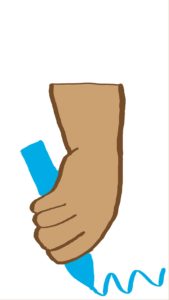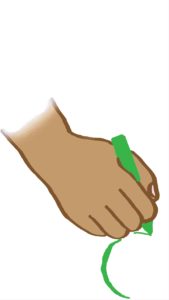Being able to write is a valuable life skill. Not only is it necessary for participation and learning in many activities at school, it is also a great way to be creative and express yourself. Picking up a pencil to write a story, participate is a lesson at school or tackle some homework may seem like a simple task but when you break down all the factors that contribute to handwriting, it is actually quite a tricky tale.
Learning to write is a progressive journey which can begins in infancy. Infants develop their grasps by hold and release toys such as rattles, they develop isolated finger movements when the pick up tiny items between their thumb and pointer, they then go on to begin to crawl and this strengths their shoulders, arms, wrists and intrinsic muscles of their hands. As an infant a child may begin to show interest in holding a pencil and making marks or scribbles on paper.
As a child grows, they begin to imitate, copy and draw what are called pre-writing lines and shapes. These generally progress in the order of horizontal lines, vertical lines, circles, diagonal lines, crosses, squares and triangles. Pre-writing lines and shapes are the bases for forming letters and numbers. When a child begins school (often around age 5), it is usually expected that they can copy all the pre-writing shapes and begin to copy letters and numbers.







Examples of
Pre-Writing
Shapes
A child’s grasp on a pencil will also often change as they grow and there can be many variations of pencil grasps. The most effective pencil grasp is referred to as a tripod grasp which allows for dexterity, isolated finger movement and control. A child’s readiness for handwriting and ability to be able to hold a pencil in an effective grasp and be comfortable and confident with handwriting can be influenced by:
- Core strength and control
- Shoulder stability
- In hand manipulation
- Finger dexterity and coordination
- Hand and finger strength
- Bilateral integration
- Visual motor skills
- Visual perceptive skills
- Attention and memory
- Understanding of language
- Planning and sequencing skills
As you can see, a lot is involved in the process of handwriting, much of which we are not often conscious about. Next time you are writing a shopping list or jotting down notes, take a moment to think about all the muscles and areas of your brain that are working together to help you sit upright in a chair, stabilise your arm and hold and move the pencil to make those meaningful marks on paper.
If a child is suspected to be having difficulty with handwriting, dislikes or avoids handwriting, seems to have an awkward grasp on a pencil, has messy handwriting or appears to be behind other children of similar age, one or more of the above factors may be contributing.
How can an Occupational Therapist help?
An Occupational Therapist can help with handwriting difficulties by working together with you and your child to identify the underlying aspects that may be impacting on handwriting. An individualised, fun and effective intervention plan involving compensatory and/or remedial approaches to be used in therapy, at home and in the classroom can then be created.


Digital Grasp

Modified Tripod Grasp

Tripod Grasp
For more information on each grasp, click on pictures
- Article by Gael Sutherland
- Published:
